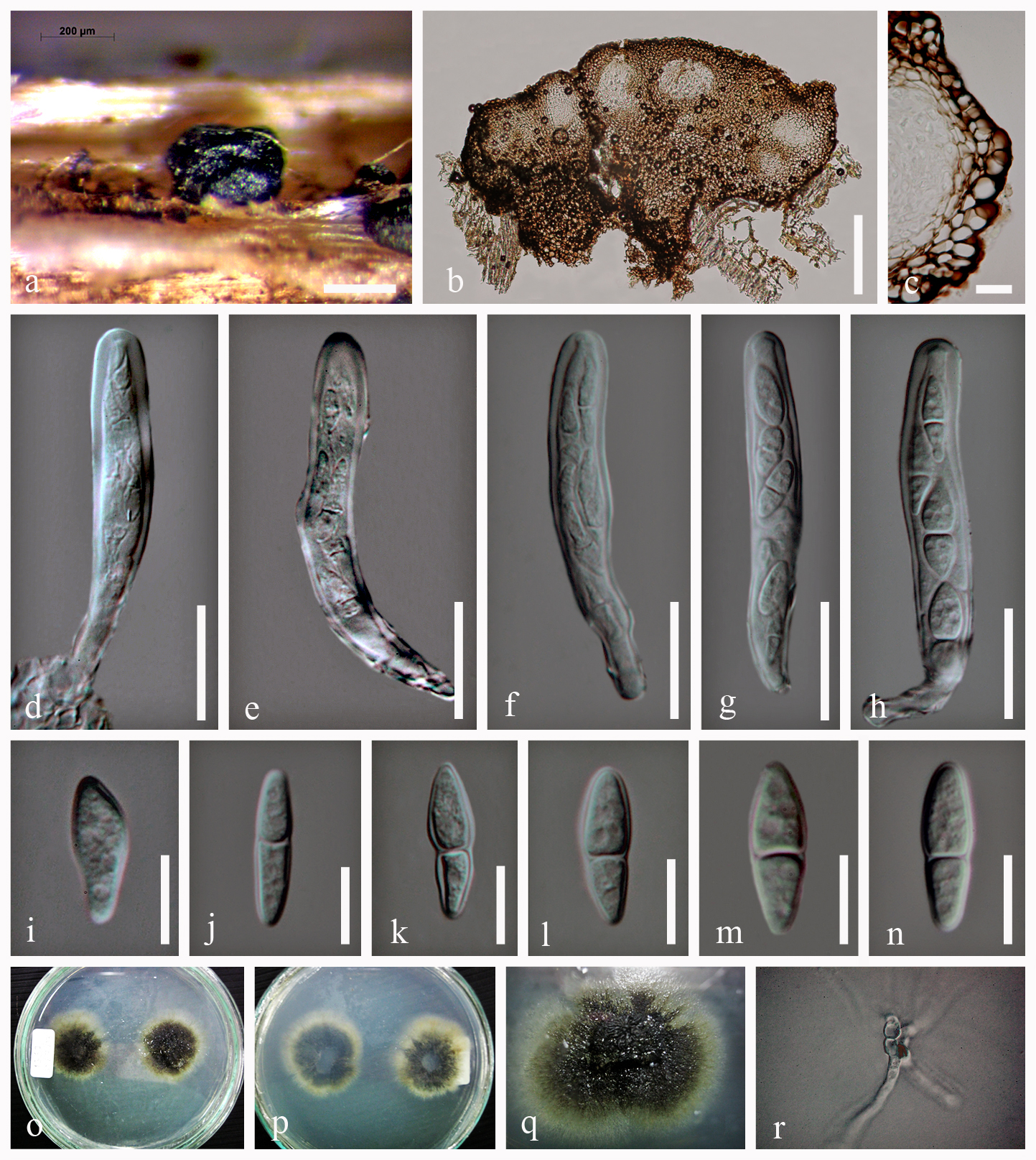Dothidea insculpta Wallr., Fl. crypt. Germ. (Norimbergae) 2: 864 (1833)
≡ Plowrightia insculpta (Wallr.) Sacc., Syll. fung. (Abellini) 2: 636 (1883)
≡ Plowrightia insculpta (Wallr.) Sacc., Syll. fung. (Abellini) 2: 636 (1883)
≡ Scirrhia insculpta (Wallr.) M.E. Barr, Contr. Univ. Mich. Herb. 9(8): 565 (1972)
Index Fungorum number: IF 173197, MycoBank number: MB 173197, Facesoffungi number: FoF 00068
Saprobic on a dead branch of Clematis vitalba. Sexual state: Ascostromata 92–192 µm high × 63–198 µm diam (x̄ = 144 × 134 µm, n = 7), dark brown to black, superficial on host tissue, solitary, scattered, globose to subglobose, coriaceous, multiloculate, with 2−4 locules, cells of ascostromata composed of dark brown-walled cells of textura angularis. Locules 91−125 × 109−144 µm (x̄ = 87 × 114 µm, n = 10), globose to subglobose, non-ostiolate. Peridium of locules 27–63 µm, comprising a few layers of brown to dark brown cells of textura angularis. Hamathecium lacking pseudoparaphyses. Asci 53−79 × 8−14 µm (x̄ = 65 × 11 µm, n = 10), 8-spored, bitunicate, fissitunicate, cylindrical to oblong, with a short pedicel, rounded at the apex with an ocular chamber. Ascospores 11−23 × 5−7 µm (x̄ = 16 × 6 µm, n = 20), overlapping uni to biseriate, broadly ovoid or ellipsoid, hyaline, 1-septate, constricted at the septum, upper cell broader than the lower cell, smooth. Asexual state: See notes.
Cultural characteristics − Ascospores germinating on MEA or PDA within 36−48 h. Colonies growing on MEA or PAD, reaching 3−5 cm in 5 days at 18−20°C, rhizoid colonies, flat, rough surface, rhizoid edge, opaque opacity, dull green mycelium, dark green around the colonies, produce some odor and clearing effect on media.
Material examined − ITALY, Poggio alla Portacce-Pratomagno (Province of Arezzo [AR]), on a dead branch of Clematis vitalba L. (Ranunculaceae), 30 June 2013, Erio Camporesi (MFLU 14−0156), living culture MFUCC 13−0686.
Notes − We could not locate the type specimen of Dothidea insculpta and our specimen can be considered as an authentic specimen. Hess and Müller (1951) introduced a monotypic genus Asteromellopsis and described Asteromellopsis insculpta H.E. Hess & E. Müll. as the asexual state found in young ascomata of Dothidea insculpta found in nature. Luttrell (1951a) found a microconidial state in young stromata of Dothidea collecta (Eriksson 1981; Shoemaker and Hambleton 2005). We did not observe formation of an asexual state in the culture.
Fig. 1 Dothidea insculpta (MFLU 14−0156) a Appearance of ascostromata on host. b Vertical section through ascostroma with asci. c Section of peridium. d Immature ascus. e-h Mature asci. i Immature ascospore. j-n Mature ascospores. o Colony on PDA medium. (upper) q Colony on PDA medium. (lower) r Germinating ascospore. Scale bars: a, b = 200 µm, c-h = 20 µm. i-n = 10 µm.

